19 MINUTE READ

What will you read in this blog about Karnataka architecture –
- To Start with Some Background
- Phases of Architecture in Kerala
- Magical Mysore
- Majestic Temples of Karnataka
- Famous Places in Karnataka
- Vernacular Architecture of Karnataka
- Contemporary yet Vernacular Bungalow of Karnataka
- Places to Visit in Karnataka
- Concluding Lines
Enjoy reading!
To Start with Some Background!
Karnataka’s architectural history spans from the Neolithic period, around 2000 BCE, when it evolved from simple shelters to ritualistic and religious structures. Early Neolithic people built huts using wattle and daub, supported by stone and bamboo, as seen in archaeological sites like Brahmagiri. The early Iron Age introduced megalithic stone burials, laying the groundwork for lasting architectural styles.

With the rise of the Kadamba Dynasty, active religious architecture emerged. Karnataka’s diverse architectural heritage reflects the influence of twelve dynasties, including grand monuments like the Gomateshwara monolith, Hindu and Jain temples, palaces, and mausoleums. The Mysore Kingdom (Wodeyar dynasty) added landmarks like St. Philomena’s Church and Dravidian-style temples. Karnataka also boasts UNESCO World Heritage sites at Pattadakal and Hampi, highlighting its cultural significance.
Post-1947, the influx of Tibetan refugees brought traditional Tibetan architecture, as seen in the Bylakuppe monastery. Modern structures like Bangalore’s Vidhana Soudha and the Murudeshwar Temple showcase Neo-Dravidian influences, continuing the region’s architectural evolution.
Phases of Architecture in Karnataka
| PHASES | YEARS |
| Kadamba Architecture | 345 to 525 |
| Dravidian architecture (Western Ganga Dynasty) | 350 to 550 |
| Badami Chalukya Architecture or the Vesara Style | 543 to 753 |
| Dravidian & Rekhanagara architecture of Rashtrakutas | 753 to 973 |
| Western Chalukya architecture (Kalyani Chalukyas) | 1000 and 1200 |
| Hoysala Architecture of the Hoysala Empire | 1100 and 1400 |
| Vijayanagara Architecture | 1336 to 1648 |
| Indo-Islamic architecture of the Deccan Sultanates | 1490 to 1686 |
| Keladi Nayaka architecture of the Nayaka kingdoms | 1499 – 1763 |
| Blends of Hindu, Indo-Islamic, Rajput, and Gothic styles of Architecture | 1399 to 1947 |
| Indo-Sarcenic and Muslim architecture of Tippu Sultan | 1780 |
| Buddhist Viharas, Tibetan Culture & Tibetan Architecture at Bylakuppe | 1953 to present |
| Sikh architecture of Bidar & Bangalore | 1512 to present |
| Neo-Gothic Church Architecture | 1933 to 1956 |
| Neo-Dravidian Architecture | 1947 to present |
Kadamba Architecture

The Kadamba dynasty (345–525) significantly contributed to Karnataka’s architectural heritage. Known for initiating the Karnataka architectural style, the Kadambas incorporated elements from earlier traditions, like those of the Satavahanas. The standout feature of their architecture is the Kadamba Shikara, a pyramid-shaped tower with a kalasha at the top, often without decoration. This style influenced later structures, such as the Doddagaddavalli Hoysala Temple and Mahakuta temples. One notable example is the Madhukeshwara Temple in Banavasi, originally built by the Kadambas and renovated by later dynasties. The annual cultural festival “Kadambotsava” is held here in December.
Dravidian Architecture
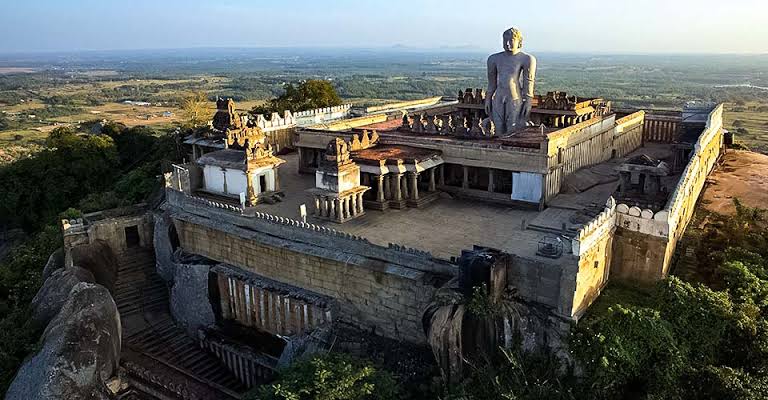
Under the Western Ganga Dynasty, numerous temples for Jain, Shaiva, and Vaishnava traditions were constructed, showing tolerance for different faiths. Notable monuments include the 983 CE Gomateshwara statue at Shravanabelagola, the largest monolithic statue in the world, and the Panchakuta basadi, a Jain temple combining Dravidian, Vesara, and Nagara styles. The Ganga rulers also built Vaishnava temples, such as the Narayanaswami temples in Nanjangud. Talakad, an ancient city along the Cauvery River, flourished under the Gangas and later dynasties, including the Hoysalas.
Nanjangud Temple

Located on the Kabini River’s bank, Nanjangud Temple, built in Dravidian style, originated during the 9th-century Ganga Dynasty and was later expanded by the Cholas, Hoysalas, and Wodeyars. It is one of Karnataka’s largest temples, with a Gopura (tower) that is 120 feet tall and houses more than 100 Lingas, including the Srikanteshwara Linga.
Badami Chalukya Architecture

This architectural style emerged between the 5th and 8th centuries in the Malaprabha basin of Karnataka. The Badami Chalukyas, known for their valor and temple-building skills, created two types of monuments: rock-cut cave temples and surface structural temples. The four Badami cave temples, carved in the 6th century, reflect different faiths—three Hindu caves and one Jain cave—featuring finely carved pillars, sculptures, and ceiling panels.
Dravidian and Rekhanagara Style of Rashtrakuta Architecture

The Rashtrakutas of the Deccan (753–973 CE), who ruled from Manyakheta in present-day Karnataka, made significant contributions to Indian temple architecture, blending Dravidian and Rekhanagara styles. This era is often referred to as the “Karnataka Dravida” style, distinct from traditional Southern Dravidian architecture. Rashtrakuta monuments, especially at Pattadakal and the Navalinga temples, are notable examples.
Pattadakal Group of Monuments
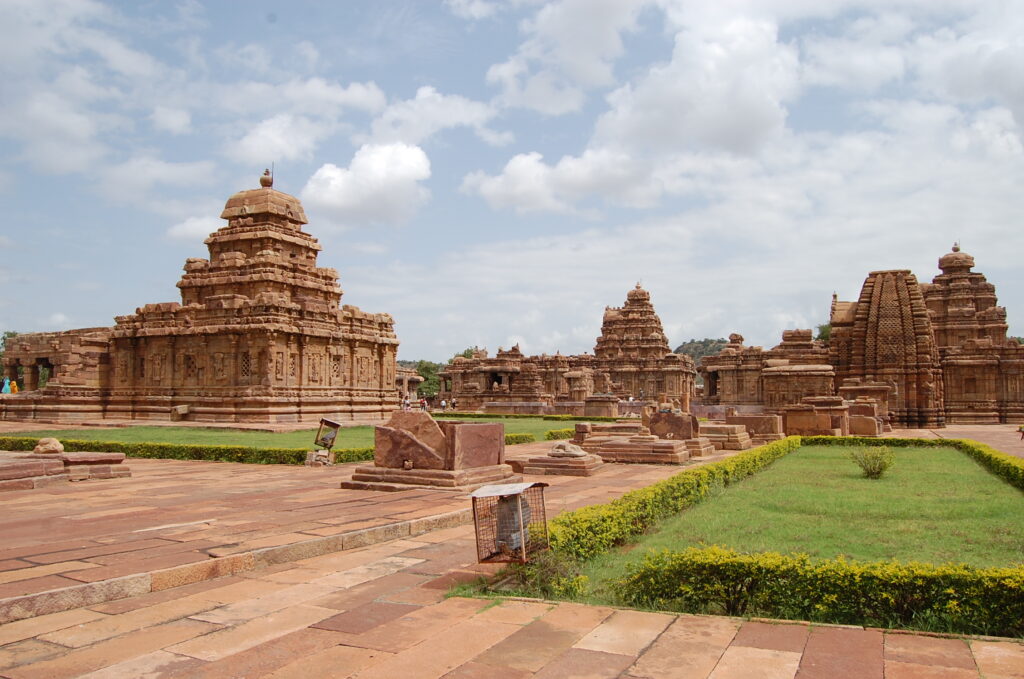
Pattadakal, a UNESCO World Heritage Site in Karnataka, is known for its blend of Dravidian (Southern) and Rekhanagara (Northern) styles of architecture. The temple complex includes:
Virupaksha Temple: Built-in 745 CE by Queen Lokamahadevi to commemorate her husband’s victory, it is inspired by the Kailashnatha temple in Kanchi.
Sangameshvara Temple: Constructed by King Vijayaditya, this temple showcases Pallava influences with its square plan and three-tiered vimana.
Galaganatha Temple: An example of Rekhanagara architecture, built around 750 CE, featuring sculptures like Shiva slaying Andhakasura.
Papanatha Temple: Built in Vesara style, with a mixture of Nagara and Dravidian elements, it features detailed carvings from the Ramayana and Mahabharata.
Navalinga Temple: Located in Kukkanur, this 9th-century temple complex consists of nine individual temples, each dedicated to Shiva and houses a linga. Built in Dravidian style, this cluster is attributed to the reign of King Amoghavarsha I or his son Krishna II.
Western Chalukya Architecture

Also known as Kalyani Chalukya architecture, the Western Chalukyas contributed to temple design between the 10th and 12th centuries, primarily in central Karnataka’s Tungabhadra region. This style is recognized for its intricate ornamentation and transitional features between Dravidian and Nagara styles.
Lakkundi Temples: Lakkundi, a significant site during the Kalyana Chalukya period, has about 50 temples built from green schist. Notable structures include:
Kashivisvanatha Temple: Known for its intricate carvings and dual shrines dedicated to Shiva and Surya.
Brahma Jainalaya: A Jain temple dedicated to Mahavira, featuring delicate carvings in chloritic schist.
Mahadeva Temple, Itagi: Hailed as the “Emperor among temples,” the Mahadeva Temple at Itagi (built-in 1112 CE) is a prime example of Dravida articulation with a Nagara superstructure, renowned for its intricate carvings and numerous minor shrines surrounding the main linga.
Dodda Basappa Temple: This 12th-century temple at Dambal features a unique 24-pointed stellate (star-shaped) design and a seven-tiered Dravidian vimana, showcasing an innovative approach to temple planning and decoration.
Hoysala Architecture

An evolution of the Western Chalukya style, Hoysala architecture flourished in the 12th century and is renowned for its intricate sculpture, attention to detail, and use of soapstone. Some key features include highly decorated walls, star-shaped ground plans, and ornate towers.
Notable Hoysala Temples
Chennakesava Temple, Somanathapura: Built in 1268 CE, this temple is known for its remarkable symmetry and finely detailed stone carvings.
Chennakesava Temple, Belur: Constructed in 1117 CE by King Vishnuvardhana, it features detailed carvings and ornate pillars, representing the best of Hoysala artistry.
Hoysaleswara Temple, Halebidu: A two-shrined temple dating to 1121 CE, famed for its endless variety of sculptures depicting Hindu mythology.
Ishvara Temple, Arasikere: Built in 1220 CE, this temple is notable for its unique 16-pointed star-shaped mantapa and intricate architectural design, making it one of the most complex Hoysala monuments.
Vijayanagara Architecture
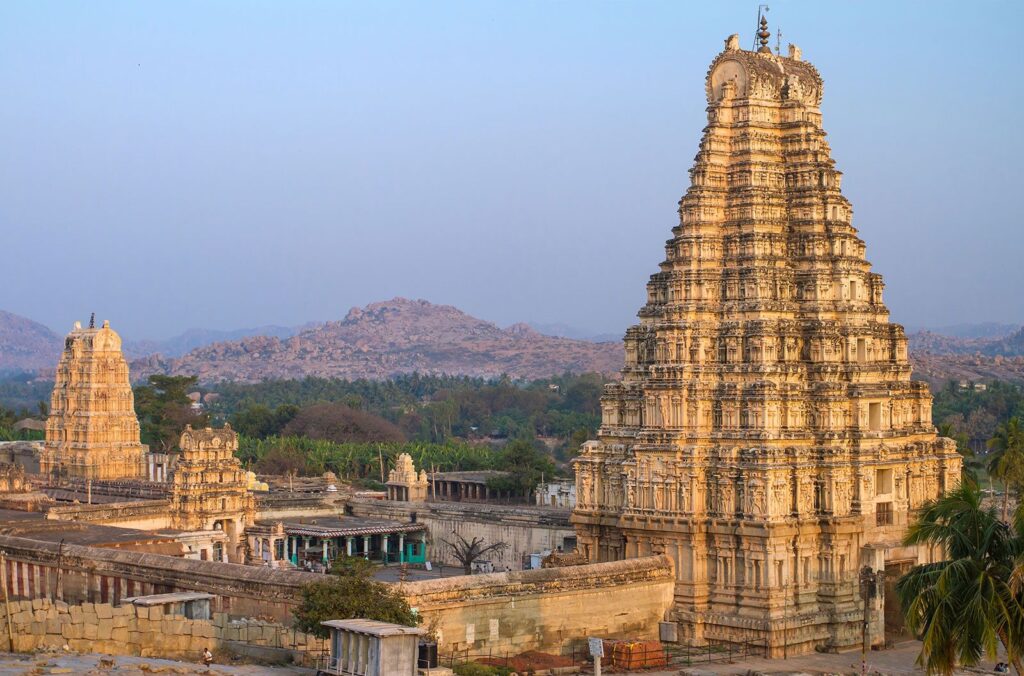
Vijayanagara architecture, flourishing from the 14th to the 16th centuries, merges influences from Chalukya, Hoysala, Pandya, and Chola styles. Key monuments include:
Virupaksha Temple: Dedicated to Lord Shiva, showcasing intricate carvings.
Vittala Temple: Famous for its stone chariot and ornate pillared halls.
Hazara Rama Temple: Features detailed depictions from the Ramayana.
Notable architectural elements include elaborate pillared halls and towering gopurams. The vast open-air site of Hampi is a UNESCO World Heritage Site and exemplifies the richness of this architectural style. The incorporation of Islamic features in some structures reflects a blend of cultures during periods of peace. The Saavira Kambada Basadi is an architectural marvel known for its 1,000 uniquely carved pillars.
Indo-Islamic Architecture
Indo-Islamic architecture in the Deccan showcases a mix of local and Islamic elements. Important examples include:
Bahmani Sultanate: Structures like Bidar Fort and the Mahmud Gawan Madrasa.
Bijapur Sultanate: Gol Gumbaz, a mausoleum featuring a massive dome and excellent acoustics, exemplifies the grandeur of this style.
Keladi Nayaka Architecture

The Keladi Nayakas (1499–1763) continued the Vijayanagara tradition with unique contributions. Notable temples include:
Rameshwara Temple, Keladi: Reflects the Hoysala-Dravida style with intricate carvings.
Aghoreshwara Temple, Ikkeri: Features yali columns and a blend of architectural styles, showcasing the artistic heritage of the Nayaka period.
This architecture emphasizes cultural narratives and religious significance, making these temples important centers of worship.
Neo-Gothic Cathedral Architecture

Shettihalli Rosary Church: Built-in 1860, this church near Shettihalli exemplifies French colonial Gothic architecture and is notable for its status as a Christian ruin.
St. Philomena’s Church: Constructed between 1933 and 1956, this church in Mysore honors St. Philomena and was designed by French architect Daly, drawing inspiration from the Cologne Cathedral in Germany.
The church features a cross-shaped floor plan, with a nave (the congregation hall), transepts, and a crossing containing the altar and choir.
It includes twin spires reaching 50 meters (160 ft) in height and a crypt housing a statue of St. Philomena. A relic of the saint is preserved in a catacomb beneath the main altar.
Indo-Saracenic Architecture
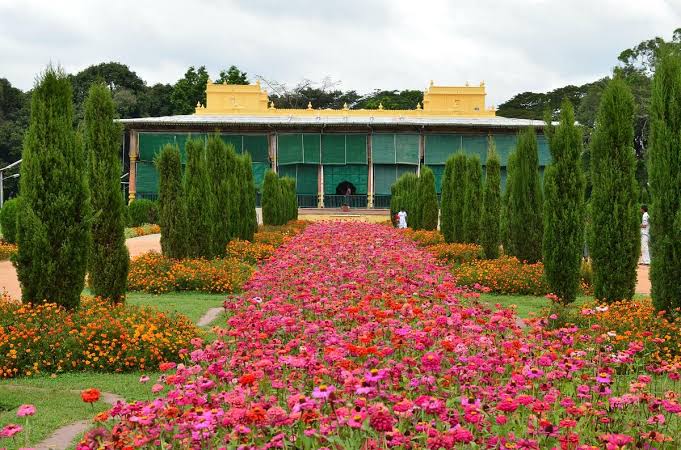
Masjid-e-Ala (Jama Masjid): Built by Tipu Sultan in 1784, this octagonal mosque features minarets on a tall platform, adorned with Persian calligraphy on its walls and ceilings.
Dariya Daulat Palace: Constructed in 1784, this palace showcases Indo-Saracenic architecture, known for its intricate woodwork and murals depicting Tipu Sultan’s military victories.
Sikh Architecture

Guru Nanak Jhira Sahib: The earliest Sikh Gurudwara in Karnataka, located in Bidar, was built at a site where Guru Nanak is said to have miraculously provided drinking water in 1512.
The central building was completed in 1966 and features a blend of Mughal and Rajput architectural styles, with onion-shaped domes and ornate frescoes. A Sikh museum commemorates Guru Tegh Bahadur and Sikh history.
Buddhist Culture & Architecture

Maha Bodhi Society: Established in 1956 in Bangalore, this society aims to propagate Buddhist teachings. The temple replicates the historic tower at Bodh Gaya and includes a stupa enshrining a relic of the Buddha.
The temple complex also features a revered Bodhi tree, symbolizing the connection to Buddha’s enlightenment.
Tibetan Buddhist Monasteries: The Namdroling Monastery in Bylakuppe, built in traditional Tibetan style, is a prominent site for Tibetan Buddhism in Karnataka. Established by Penor Rinpoche, it includes large golden statues and intricate wall paintings, embodying Tibetan culture.
Neo-Dravidian Architecture

Vidhana Soudha: Completed in 1956, this impressive structure combines Neo-Dravidian and Indo-Saracenic elements and serves as the legislative building of Karnataka. It is also known as the “Taj Mahal of South India.”
Murudeshwara Temple: Situated on Kanduka Hill and surrounded by the Arabian Sea, this temple is dedicated to Lord Shiva. It features a towering 20-story Gopura and a massive statue of Lord Shiva, making it a significant landmark.
The Magical Mysore

The Kingdom of Mysore, initially a part of the Vijayanagara Empire and later a princely state under British Raj, showcases a rich architectural heritage influenced by the Indo-Saracenic style. This style blends elements of Hindu, Islamic, Rajput, and Gothic architecture, especially evident during the Wodeyar Dynasty from 1399 to 1947.
Key Palaces
Mysore Palace: Designed by architect Henry Irwin in 1897, this Indo-Saracenic palace features a grand interior with Hoysala detailing, domes, arches, and ornate pillars. Noteworthy elements include the octagonal Kalyana Mantapa and the opulent Amba Vilas hall.
Lalitha Mahal Palace: Built-in 1921 in Renaissance style, this palace reflects English and Italian architectural influences, with a central dome inspired by St. Paul’s Cathedral.
Jaganmohan Palace: Constructed in the mid-19th century, it showcases Hindu architectural styles and features a decorative Wedding Pavilion.
Jayalakshmi Vilas Palace: Characterized by Corinthian columns, this three-winged palace is adorned with sculptures of Hindu deities.
Rajendra Vilas Palace: An Indo-British style palace perched atop Chamundi Hill, built in 1938.
Notable Temples
Within Mysore, five significant temples surround the main palace:
- Prasanna Krishnaswamy Temple (1829)
- Lakshmiramana Swamy Temple (oldest fort temple, predating 1499)
- Trinesvara Swamy Temple (renovated over the years)
- Shweta Varaha Swamy Temple (featuring Hoysala elements)
- Prasanna Venkataramana Swami Temple (built in 1836, adorned with murals of Wodeyar rulers)
- Chamundeshwari Temple: Located atop Chamundi Hills, this temple is renowned for its seven-story gopuram, constructed in 1827. The original shrine dates back to the 12th century, and the temple is dedicated to Chamundeshwari, the royal goddess of Mysore. A massive granite Nandi statue is located nearby, further enhancing the temple’s significance.
The Majestic Temples of Karnataka
Karnataka is renowned for its ancient temples that showcase extraordinary craftsmanship, reflecting the artistic and spiritual heritage of the region. These temples, often dedicated to various deities, stand as living testaments to the devotion and creativity of the people. Some of the most notable temple complexes include:
Hampi — The City of Ruins

Hampi, a UNESCO World Heritage Site, is a sprawling complex of ruins that was once the majestic capital of the Vijayanagara Empire. The intricately carved stone temples, giant monolithic statues, and the grandeur of this city are awe-inspiring. Among the must-visit gems in Hampi are the Virupaksha Temple, renowned for its stunning architecture and vibrant festivals, the Vittala Temple, famous for its iconic stone chariot and musical pillars, and the Achyutaraya Temple, which showcases exquisite carvings and an intricate layout.
Belur and Halebidu — The Twin Marvels

The Hoysala dynasty left an indelible mark on Karnataka’s architectural landscape, particularly in the twin towns of Belur and Halebidu. The Chennakesava Temple in Belur is celebrated for its detailed sculptures and artistic brilliance, each telling a unique story through intricate carvings. Similarly, the Hoysaleswara Temple in Halebidu is a masterpiece of Hoysala architecture, featuring stunning relief work and exquisite motifs that reflect the rich cultural heritage of the period. Visitors are often captivated by the remarkable attention to detail in these temples.
Badami — Cave Temples
These ancient temples chiseled into the red sandstone cliffs, provide a glimpse into the rich history of the region. The Badami Cave Temples are a fascinating fusion of Indian and Dravidian architectural styles, showcasing intricate carvings and sculptures that depict various deities and mythological scenes, making them a significant highlight for history enthusiasts and travelers alike.
The Grand Palaces
Karnataka is not just about temples; it also boasts opulent palaces that exude an air of royalty and splendor.
Mysore Palace — The Jewel of Mysore
Mysore Palace, or the Amba Vilas Palace, is a significant example of Indo-Saracenic architecture. Adorned with intricate artwork, stained glass, and beautiful gardens, it’s a sight to behold. The palace’s grandeur is amplified every Sunday when it is illuminated, casting a magical spell on its visitors. The intricate details in the architecture, combined with its historical significance, make it a must-visit landmark in Karnataka.
Bangalore Palace — A Royal Abode

Bangalore Palace, has Tudor-style architecture, which transports you to a different era. Surrounded by lush gardens, it’s a perfect blend of history and beauty. The palace features stunning woodwork, turrets, and sprawling grounds that invite exploration. Throughout the year, it hosts various cultural events and exhibitions, offering visitors a chance to experience the vibrancy of Karnataka’s heritage.
Famous Places in Karnataka
Karnataka, known as the Heritage City of Karnataka is a popular tourist destination with a rich cultural legacy. The state is renowned for its architectural marvels, including magnificent temples and regal palaces that offer a glimpse into its glorious past.
Mysore: The City of Palaces
Mysore often referred to as the “City of Palaces,” is home to the iconic Mysore Palace, which overlooks the picturesque Chamundi Hills. This regal structure exemplifies Indo-Saracenic architecture, adorned with rich colors and stained-glass windows. Notable temple structures in the vicinity include the Trineshwara Temple, Sri Gayathri Devi Temple, and Sri Bhuvaneshwari Temple. Beyond these highlights, Mysore offers a myriad of attractions, making it a vibrant hub for tourists.
Hampi: A UNESCO World Heritage Site
Located on the southern bank of the River Tungabhadra, Hampi is another jewel in Karnataka’s crown, classified as a UNESCO World Heritage Site. Once the thriving capital of the Vijayanagara Empire, this site features a vast array of ancient temples, elephant shelters, water reservoirs, and stunning ruins. Hampi boasts around 500 ancient buildings, making it a haven for history enthusiasts.
Gol Gumbaz, Bijapur: An Architectural Marvel
Gol Gumbaz in Bijapur, built during the rule of the Chalukyas and later by the Delhi Sultanate, is a historical site housing the tomb of Mohammed Adil Shah, the seventh monarch of Bijapur. This Indo-Islamic architectural wonder took 20 years to construct and features one of the largest domes of its time, measuring 51 meters high and 44 meters wide. Its unique design includes a gallery that reverberates seven times, creating a captivating acoustic experience.
Pattadakal: Where Art Meets Architecture
The Group of Monuments at Pattadakal, a UNESCO World Heritage Site, showcases the architectural brilliance of Karnataka. The Virupaksha Temple, also known as Lokeshwara, stands out for its stunning craftsmanship. Nearby, the Jambulinga Temple features exquisite sculptures of Lord Shiva alongside Nandi and Parvati. Pattadakal is renowned for its intricate stone art, blending various architectural styles, including a Jain shrine from the Rashtrakuta era adorned with magnificent elephant sculptures.
Murudeshwar: A Spiritual and Scenic Paradise

Murudeshwar offers something for everyone, from serene temples and pristine beaches to adventurous sports and lush forests. Dominating the landscape is the towering statue of Lord Shiva, the second-highest in the world, standing at 123 feet. The Murudeshwar Temple, accompanied by a 20-story gopura, and attractions like Koosalli Waterfalls, Netrani Island, and Mirjan Fort make this destination a must-visit.
Chennakeshava Swamy Temple: A Historical Gem
The Chennakeshava Swamy Temple in Hassan, dating back to the 12th century, is a significant historical site dedicated to Lord Vishnu. Built during the Hoysala Empire, it features remarkable art depicting scenes from 12th-century life, showcasing architecture, sculptures, and iconography. The temple is unique for its integration of various religious elements, including Shaiva, Shakti, Jain, and Buddhist motifs.
Srirangapatna: A Historical Island Town
Located 18 kilometers from Mysore, Srirangapatna is an island town in the Cauvery River, rich in Hoysala and Vijayanagar architecture. The Ranganathaswamy Temple, dedicated to Lord Vishnu, is a major pilgrimage site, attracting thousands of visitors annually. The town is steeped in historical significance, known for the martyrdom of the valiant ruler Tipu Sultan and the Fourth Anglo-Mysore War.
Badami Caves: A Testament to Ancient Architecture
The Badami Caves in Bagalkot, dating back to the 6th century CE, exemplify the Chalukya Empire’s architectural prowess. Comprising four cave temples—one Jain and three Hindu—these caves feature intricate carvings, decorative pillars, and rich ceiling panels, offering insights into the artistic traditions of the era.
Aihole: The Cradle of Temple Architecture

Aihole, situated on the banks of the Malaprabha River, is renowned for its historical significance and architectural heritage. Considered the birthplace of South Indian temple construction, Aihole is home to approximately 125 temples built between the 5th and 8th centuries during the Badami Chalukya reign. The site features diverse temple styles, making it a treasure trove for architecture enthusiasts.
Bidar Fort: A Marvel of Military Architecture
Bidar Fort, built by Sultan Alla-Ud Din Bahman of the Bahmanid Dynasty, is a prominent historical structure crafted from red laterite stone. Renowned for its architectural features, including the Rangin Mahal, Takht Mahal, and Sola Khamba Masjid, the fort is also famous for its medieval water delivery system known as “Karez,” showcasing the ingenuity of the people during the Late Medieval period.
Modern Architectural Wonders
Visvesvaraya Tower: This 85-meter tall building in Bangalore was named after Sir M Visvesvarayya, a prominent engineer. Designed by architect Charles Correa, it reflects the principles of Brutalist architecture and houses several government offices.
Vidhana Soudha: As the largest legislative building in India, Vidhana Soudha is a striking example of neo-Dravidian architecture, incorporating elements from various Karnataka dynasties. Its grand facade, adorned with granite columns, features the State Emblem of India atop its central dome.
Bangalore Palace: This majestic palace, built in 1878, is a stunning example of Scottish Gothic and Tudor architecture. With its intricate woodwork and royal artifacts, it remains a top tourist destination in Bangalore.
Glass House at Lalbagh: Built-in 1889 and inspired by the Crystal Palace, the Glass House in Lalbagh Botanical Gardens hosts flower shows and is renowned for its architectural beauty.
Seshadri Memorial Library: Dedicated to Sir K. Sheshadri Iyer, this library features Tuscan and Corinthian architectural styles. Surrounded by lush gardens, it is a peaceful haven for book lovers.
Vernacular Architecture of Karnataka
Traditional Houses in Karnataka
Gutthu Houses

Community: Land-owning community of South Karnataka.
Architecture: Large, inward-looking Hindu mansions with steeply pitched roofs.
Design Features:
Combination of single and double-story blocks around a central courtyard.
Symmetrical facades with a central projection, are often the tallest feature.
Constructed primarily from wood, these houses were designed to deter attacks and provide security.
Bunt Houses (Guthu Mane)
Community: Bunt community of coastal Karnataka, particularly in Tulu Nadu.
Structure: Square complexes with wooden pillars supporting the roof, often covered with Mangalore tiles.
Design Elements:
Four entrances, one on each side of the square.
An open inner courtyard, frequently used for drying items and communal activities.
Notable Example: Kodial Guthu, a well-preserved house in Mangalore.
Ain Mane Houses (Kodagu/Coorg)
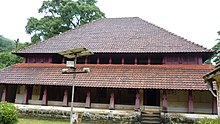
Community: Kodava people, are known for their martial traditions and clan system.
Structure: Ancestral homes (Ain Mane) that serve as the family’s hub.
Design Features:
Massive entrance columns and a central open courtyard.
The architecture reflects a fortified structure, promoting unity within the family and clan.
Each Ain Mane is typically surrounded by huts for farm workers and animal sheds, emphasizing communal living.
Cultural Significance: The Ain Mane is a vital part of Kodava culture, facilitating gatherings during festivals and important events, and reinforcing familial bonds.
Architectural Details of Ain Mane:
Central Elements:
Kannikamba: A central pole supporting the roof, significant in rituals and family ceremonies.
Kaimada: A structure for honoring the family’s founder, highlighting the importance of ancestry in Kodava culture.
Functional Spaces:
Padasale: A hall surrounding the courtyard.
Mundu: The open courtyard at the heart of the home.
Kanni Kombara: A prayer area for family deities, integrating spirituality into daily life.
Kitchen: Sacred space, often separated from living areas to manage smoke.
Cultural Reflection:
Vernacular architecture in Karnataka serves as a testament to the region’s rich cultural heritage. It embodies the values, traditions, and lifestyles of its communities. By prioritizing local materials, climate considerations, and social structures, these traditional houses not only meet the functional needs of their inhabitants but also foster a sense of belonging and identity.
In essence, vernacular architecture is a narrative of human adaptation to the environment, providing a blueprint for sustainable living that harmonizes with nature and community values. Through the study of structures like Gutthu houses, Guthu Mane, and Ain Mane, we gain insight into the historical and cultural significance of architectural practices that resonate deeply within Karnataka’s diverse landscape.
Contemporary yet Vernacular Bungalow of Karnataka
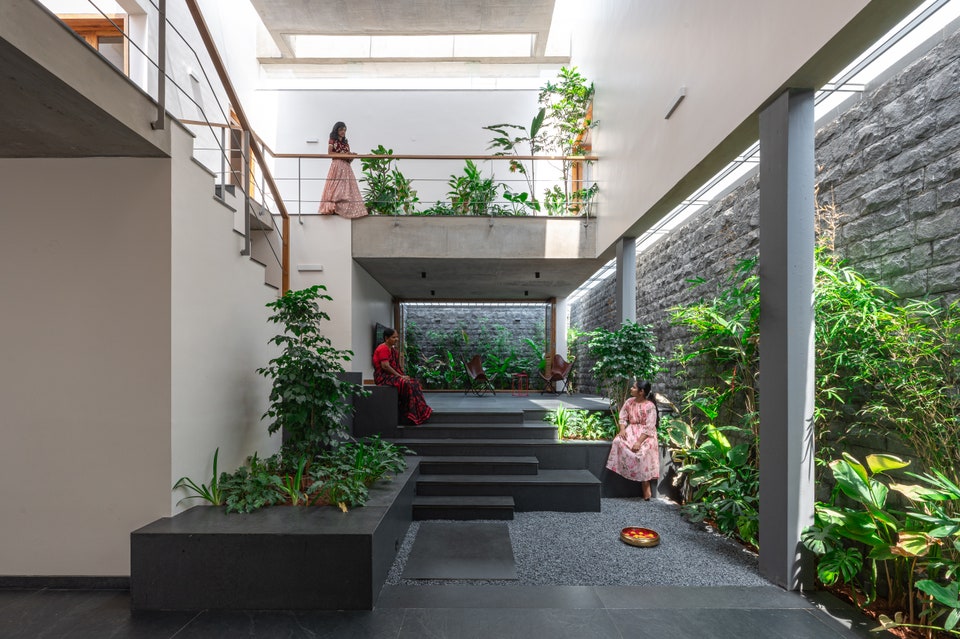
In the heart of Tiptur, Karnataka, a couple has transformed their vision of a family home into reality, drawing inspiration from the traditional katte—a symbol of community and social interaction in rural Karnataka. This elevated platform serves not only as a gathering spot for villagers but also reflects the couple’s desire to create an open, nature-connected environment for themselves and their two teenage daughters.
Architectural Vision
Design Team: Architects Avinash Ankalge and Harshith Nayak of A Threshold
Site: A 4,200-square-foot plot located in a serene rural setting, free from immediate neighbors or established architectural context.
Design Elements
Materiality: The exterior features a random rubble black granite stone wall, sourced from a nearby quarry, creating a fortress-like feel. The all-white façade contrasts beautifully against this dark stone, giving the home a floating appearance.
Indoor-Outdoor Flow: The home recreates the stepped gathering platforms typical of Tiptur through interconnected indoor-outdoor spaces, resembling multiple verandahs. This design fosters semi-public gathering zones that breathe life into the home, echoing the vibrancy of village life.
Courtyards and Gathering Spaces: The strategic use of staggered, overlapping courtyards enhances views and connectivity within the house, encouraging interaction with nature and among family members. Gardens are integrated at every level, reinforcing the relationship between indoor spaces and the surrounding landscape.
Living Spaces: The open-plan living room and kitchen extend into a kitchen garden, reflecting the family’s agricultural background. First-floor bedrooms feature large sliding doors that connect directly to courtyards, promoting fluid movement between spaces.
Color and Design Details: A minimalist palette of white-washed walls and raw concrete is punctuated by a bold yellow metal staircase, dubbed the “Charlie Chaplin staircase” due to its playful uneven steps. This feature not only adds a dramatic element but also maximizes vertical space within the home.
This thoughtfully designed residence in Tiptur embodies the spirit of community and nature, seamlessly integrating local architectural traditions with contemporary living. It stands as a testament to how traditional concepts can inform modern design, creating spaces that are not only functional but also rich in cultural significance.
Places to Visit in Karnataka
Coorg (Kodagu)
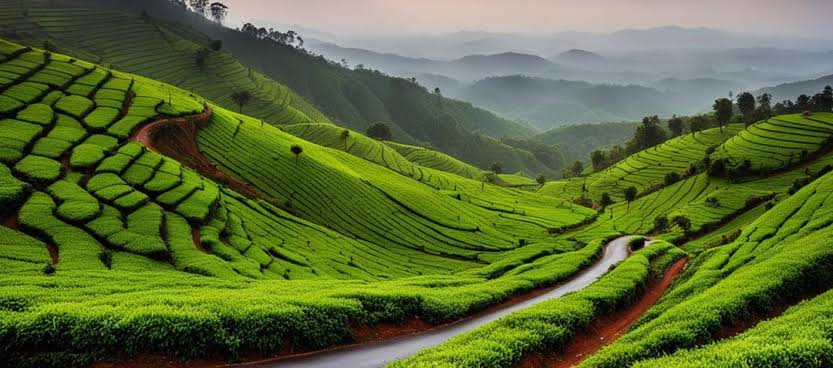
Overview: Nestled in the Western Ghats, Coorg is renowned for its coffee plantations and stunning landscapes, characterized by misty mountains and flowing streams.
Culture: The local Kodava community is known for its martial traditions and hospitality, making Coorg a welcoming destination for visitors.
Attractions: Coffee estates, scenic viewpoints, and vibrant local culture.
Badami
Overview: Known as Vatapi in ancient times, Badami is famous for its stunning sandstone cave temples and historical architecture.
Cultural Significance: A UNESCO World Heritage Site, it represents the pinnacle of traditional temple architecture in India.
Attractions: Cave temples, Agastya Lake, and remnants of ancient fortifications.
Gokarna

Overview: A picturesque coastal town, Gokarna combines spiritual significance with natural beauty, attracting both pilgrims and beach lovers.
Beaches: Notable for its pristine beaches such as Om Beach and Kudle Beach, which contrast with the town’s traditional atmosphere.
Cultural Significance: Renowned as a Hindu pilgrimage site, Gokarna offers a unique blend of sanctity and relaxation.
Udupi

Overview: Famous for its delicious vegetarian cuisine, Udupi is a vibrant coastal town steeped in temple culture and history.
Education Hub: Home to Manipal University, contributing to its dynamic atmosphere.
Attractions: Ancient temples, tranquil beaches, and lush forests.
Chikmagalur
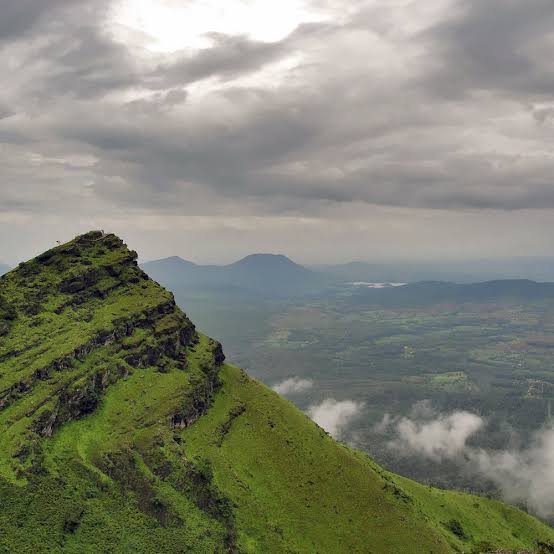
Overview: Known as the ‘Coffee Land of Karnataka,’ Chikmagalur is celebrated for its coffee plantations and breathtaking natural beauty.
Outdoor Activities: A paradise for nature enthusiasts and adventure seekers, with trekking opportunities in the Mullayangiri Range.
Attractions: Coffee estates, scenic hills, and serene landscapes.
Jog Falls

Overview: The second-highest waterfall in India, Jog Falls offers spectacular views, particularly during the monsoon season when it flows at full strength.
Unique Features: Divided into four segments—Raja, Roarer, Rocket, and Rani—each with distinct characteristics.
Accessibility: Located two hours from Shimoga, making it a popular tourist attraction.
Dandeli

Overview: A hub for adventure tourism in the Western Ghats, Dandeli is famous for its lush forests and the Kali River.
Activities: River rafting, mountain biking, and wildlife spotting in Dandeli Wildlife Sanctuary.
Attractions: Kavla Caves, Ulavi Temple, and stunning viewpoints like Sykes Point.
Bandipur National Park
Overview: Once the Maharaja of Mysore’s hunting grounds, Bandipur is now a protected reserve under Project Tiger.
Wildlife: Home to diverse flora and fauna, including elephants, deer, and various bird species.
Tourism Regulations: Traffic restrictions during night hours ensure the safety of wildlife.
Nagarhole National Park
Overview: Adjacent to Bandipur, Nagarhole offers rich biodiversity and serene landscapes, making it a paradise for nature lovers.
Wildlife Experiences: Gushing streams and lush forests create ideal conditions for wildlife sightings.
Kabini

Activities: River safaris and wildlife viewing attract visitors looking for a nature-centric experience.
Overview: Known for luxury resorts and its proximity to Nagarhole National Park, Kabini is a serene getaway destination.
Kemmanagundi

Overview: A tranquil hill station, Kemmanagundi is famous for its gardens and breathtaking views.
Activities: Offers trekking, nature walks, and sightseeing, making it ideal for outdoor enthusiasts.
Attractions: Hebbe Falls, Z Point, and beautifully maintained gardens.
Thirthahalli

Overview: A quiet town along the Tunga River, Thirthahalli is rich in natural beauty and cultural heritage.
Cultural Significance: Associated with prominent Kannada writers, the town reflects the literary and artistic traditions of Karnataka.
Kudremukh
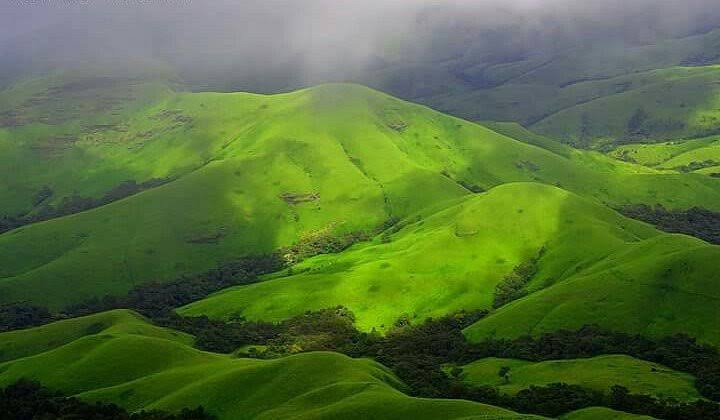
Overview: Named for its horse-like mountain shape, Kudremukh is a biodiversity hotspot and popular trekking destination.
Natural Beauty: Known for its scenic beauty, lush landscapes, and rich flora and fauna.
Shravanabelagola
Overview: An important Jain pilgrimage site featuring the iconic monolithic statue of Lord Gomateswara (Bahubali).
Cultural Heritage: Attracts numerous pilgrims and tourists to its ancient temples and serene landscapes.
The Concluding Lines!
Karnataka’s architectural heritage is a captivating tapestry woven from its rich history, cultural diversity, and natural beauty. From the intricately carved temples of Badami and Shravanabelagola to the traditional homes of the Kodavas in Coorg and the unique Ain Mane structures, each architectural style reflects the region’s unique traditions and lifestyles. The harmonious blend of natural landscapes with these structures enhances their significance, making Karnataka a treasure trove for architecture enthusiasts and travelers alike. As visitors explore the state’s ancient temples, forts, and traditional homes, they gain a deeper appreciation for Karnataka’s enduring legacy and its vibrant cultural tapestry.
References
- Wikipeia.org. (n.d.). Architecture of Karnataka. [online] Available at: https://en.wikipedia.org/wiki/Architecture_of_Karnataka
- Suryavanshi, Ramachandra (Oct. 11, 2023). Discovering the Architectural Wonders of Karnataka. [online] Available at: https://medium.com/@raju.vanshi/discovering-the-architectural-wonders-of-karnataka-328973b5938d
- Bhasker, Aaditya. (n.d.). 15 Places To Visit In Karnataka for Travelling Architect. [online] Available at: https://www.re-thinkingthefuture.com/city-and-architecture/a8202-15-places-to-visit-in-karnataka-for-travelling-architect/
- Das, Ela. (June 24, 2024). A contemporary bungalow reimagines vernacular architecture in rural Karnataka. [online] Available at: https://www.architecturaldigest.in/story/a-contemporary-bungalow-reimagines-vernacular-architecture-in-rural-karnataka-local-architecture/
- medium.com. (Dec. 17, 2016). Vernacular Architecture of Karnataka. [online] Available at: https://medium.com/welcometoindia/vernacular-architecture-of-karnataka-7740fe264b43
- www.holidify.com. (n.d.). Here are the top 103 places to visit in Karnataka in 2024. [online] Available at: https://www.holidify.com/state/karnataka/top-destinations-places-to-visit.html
![]()